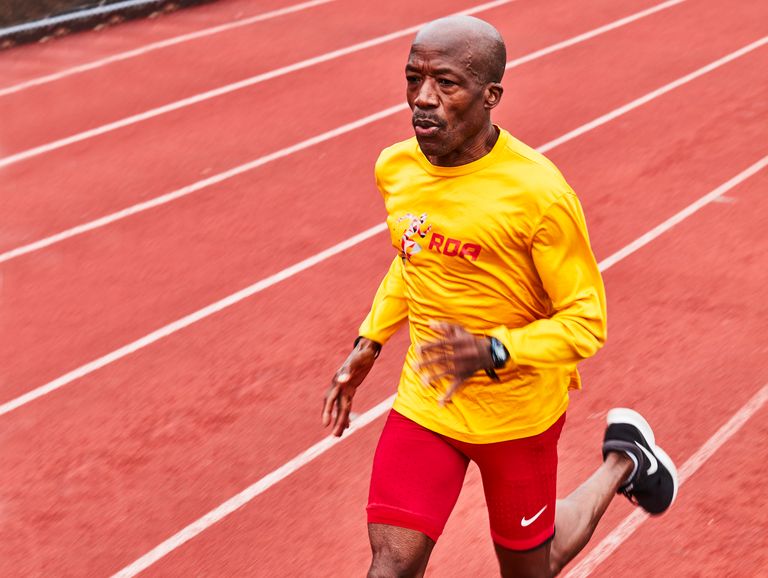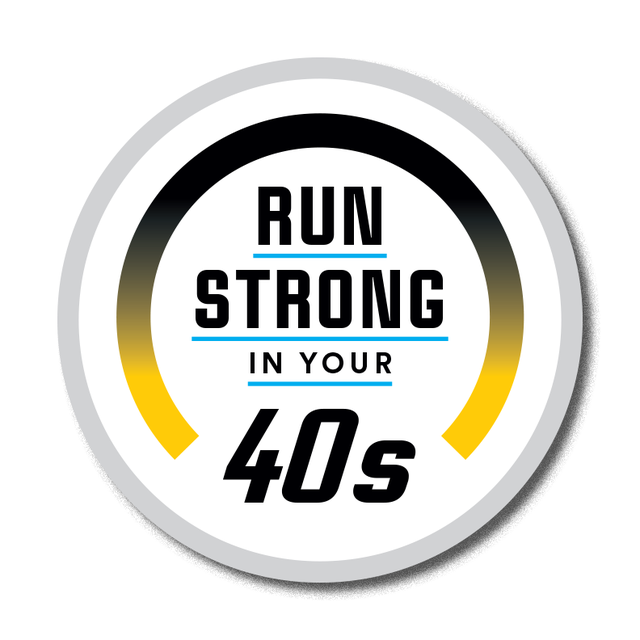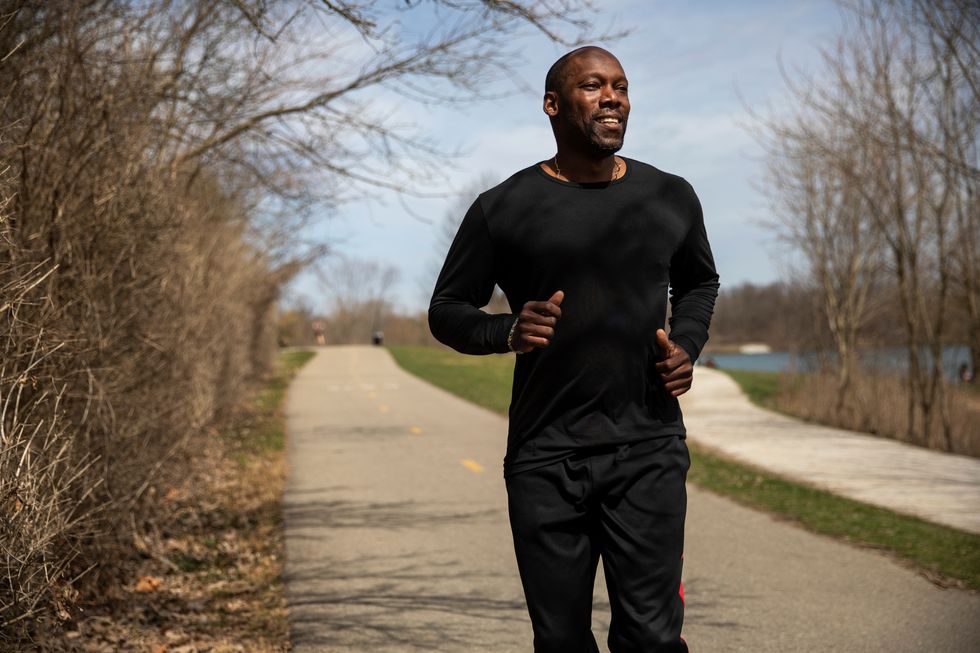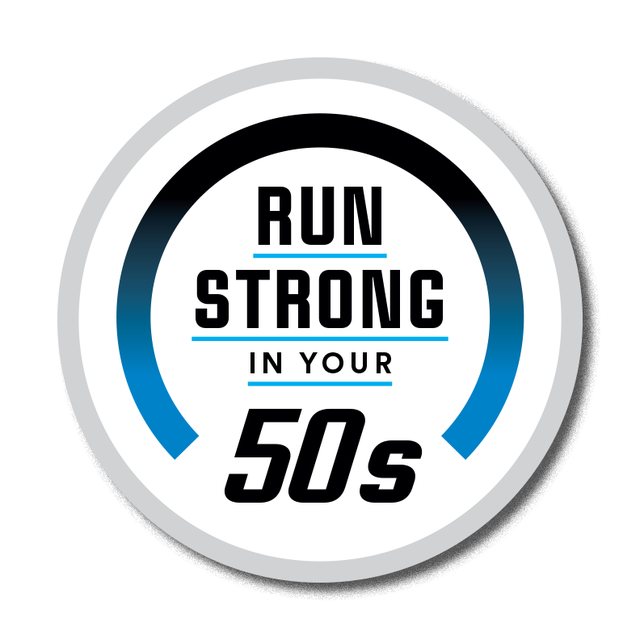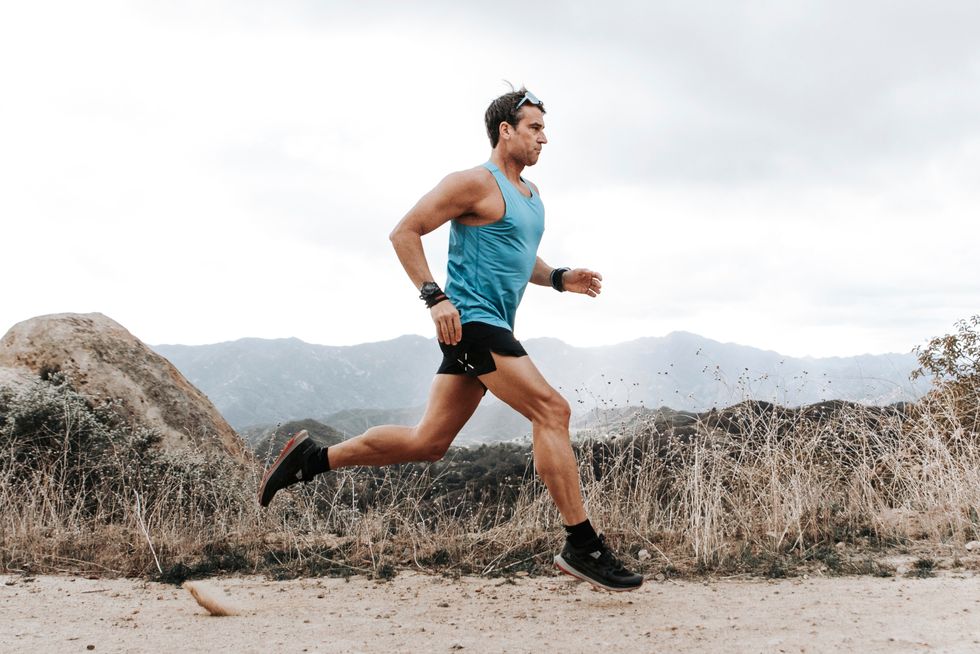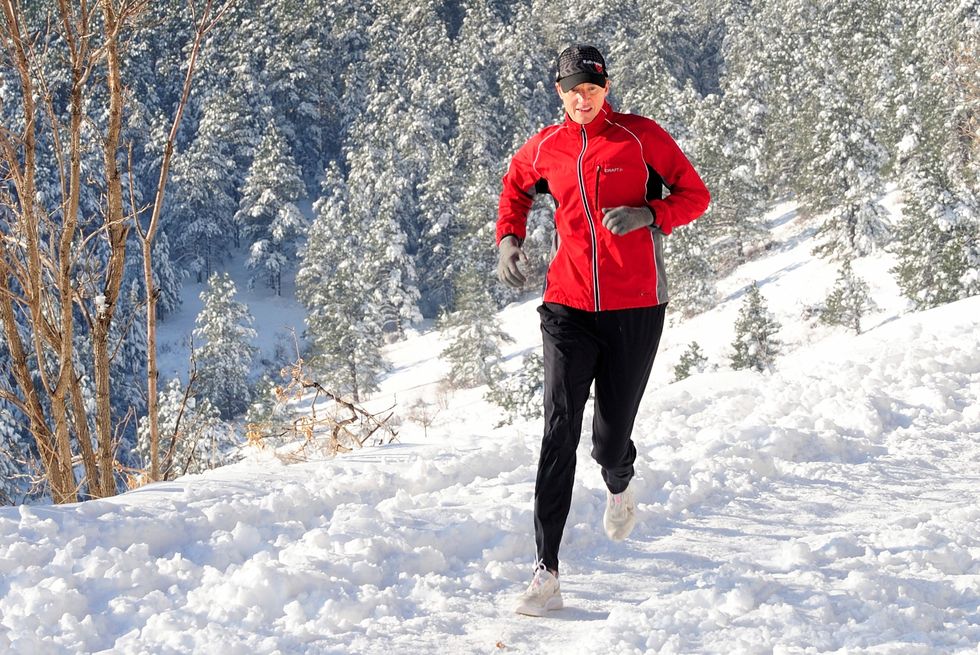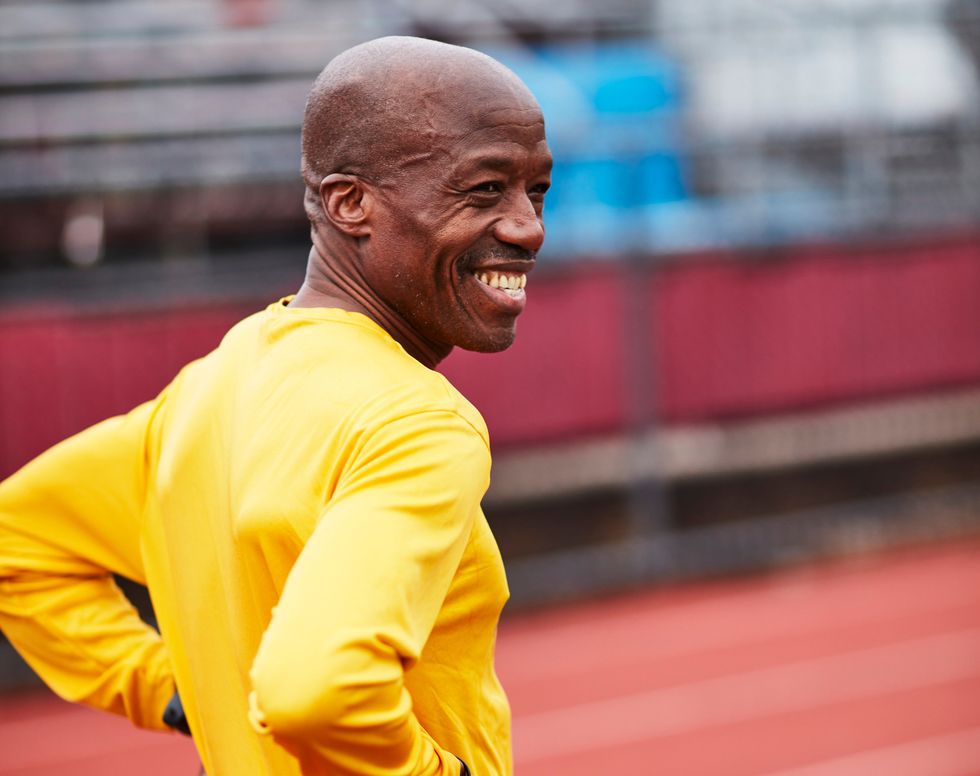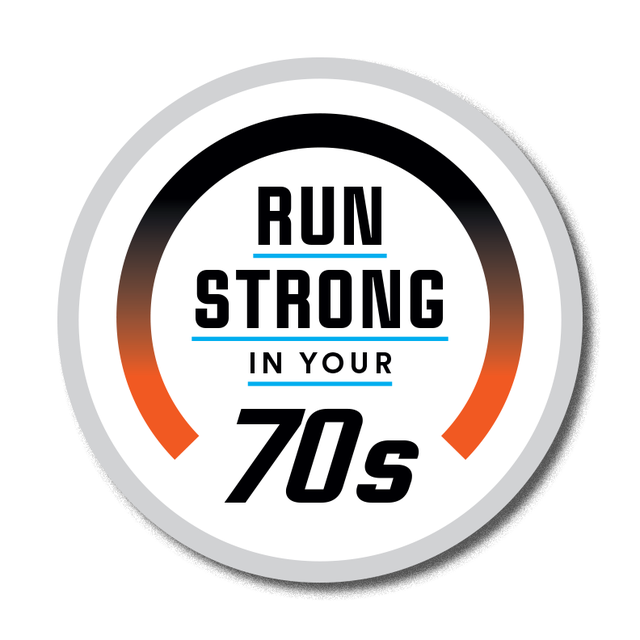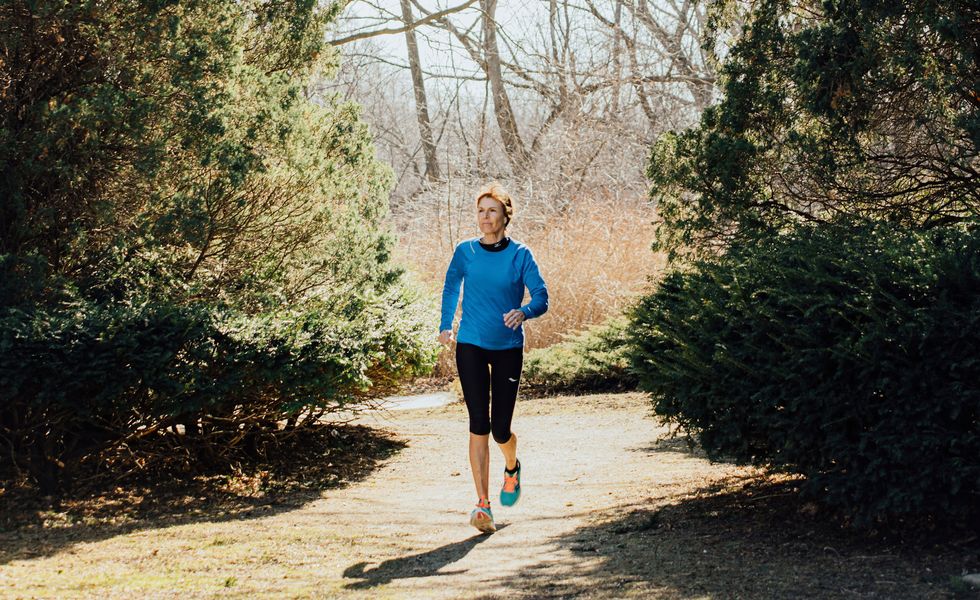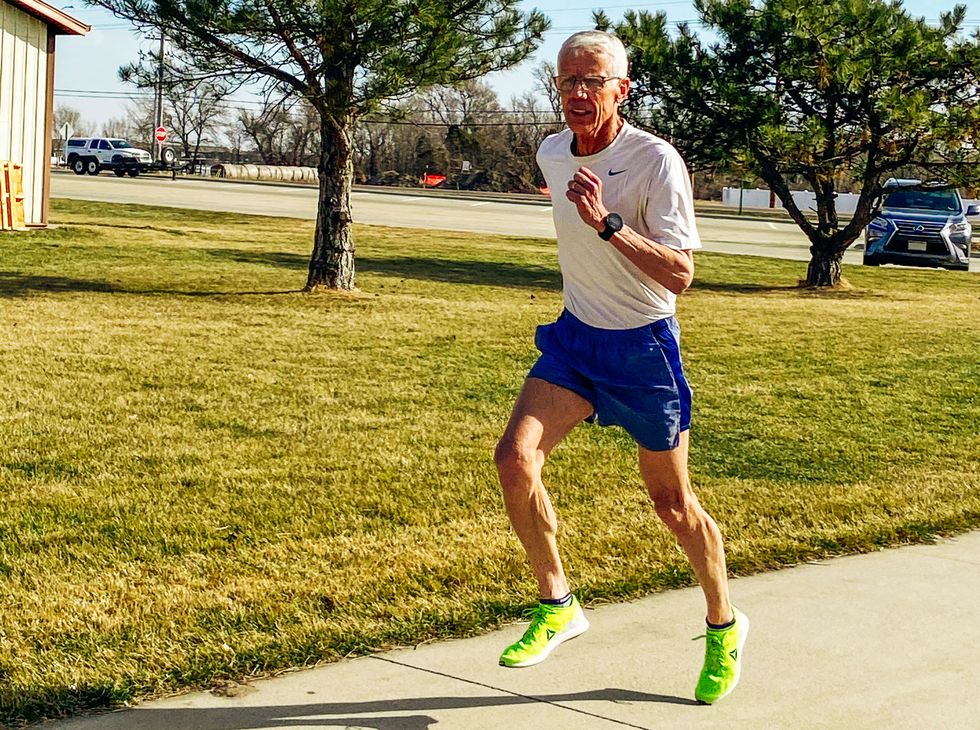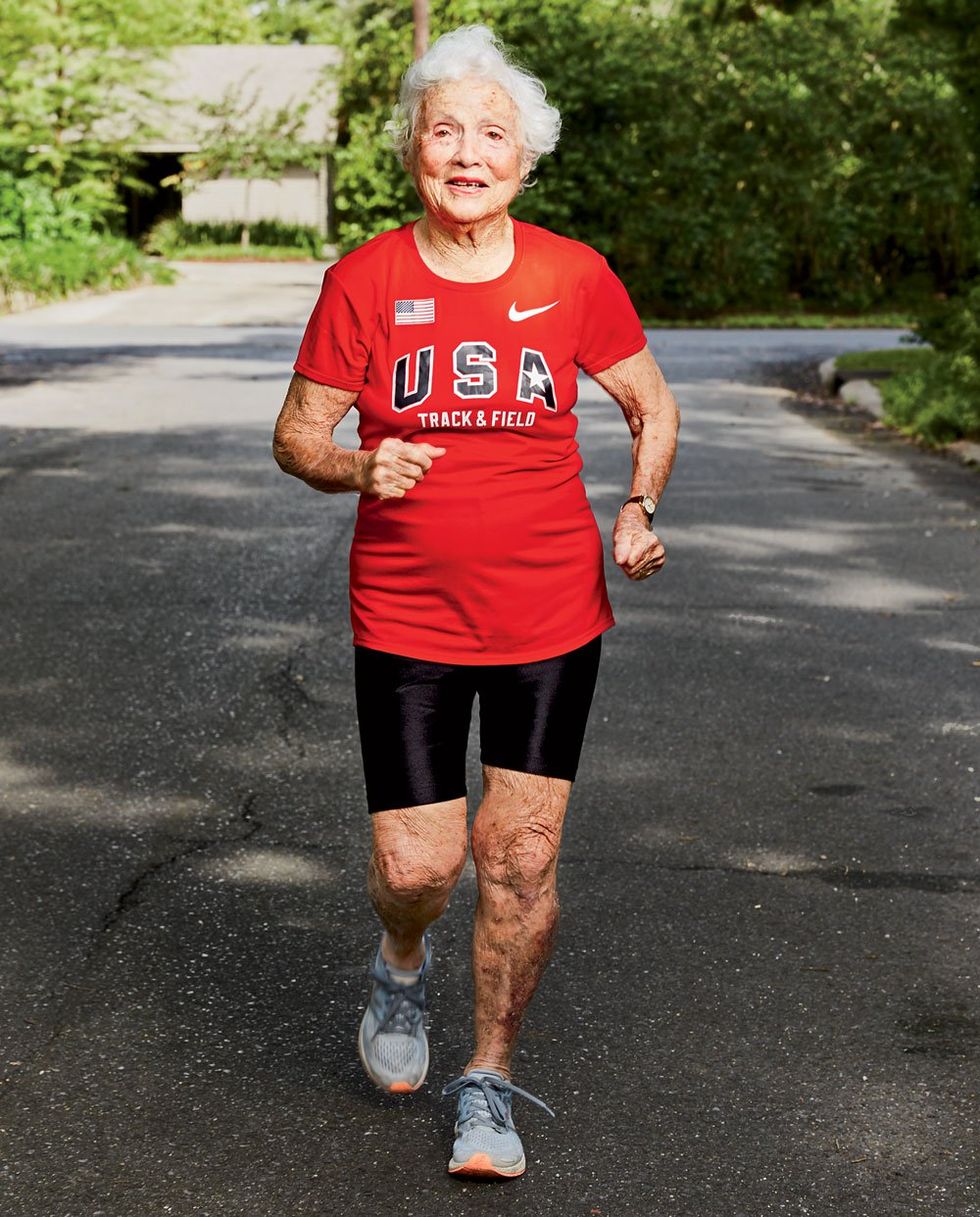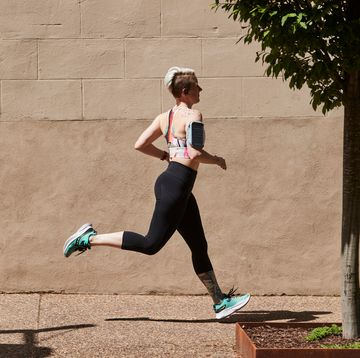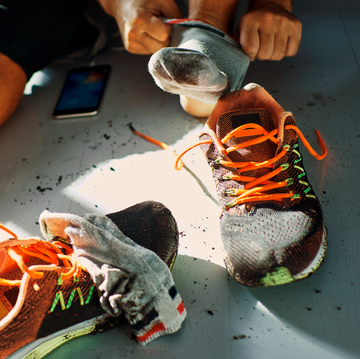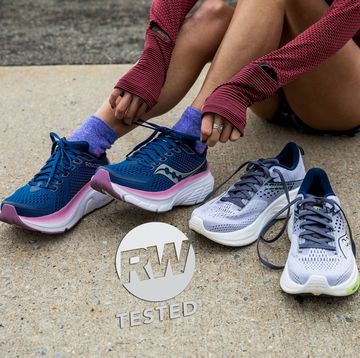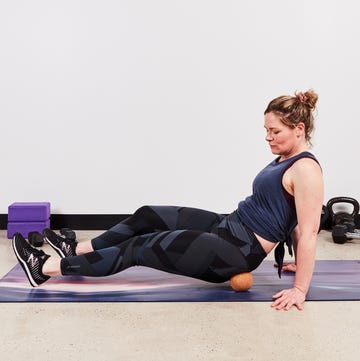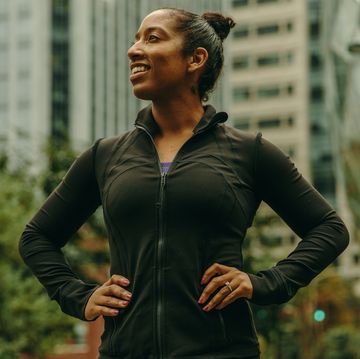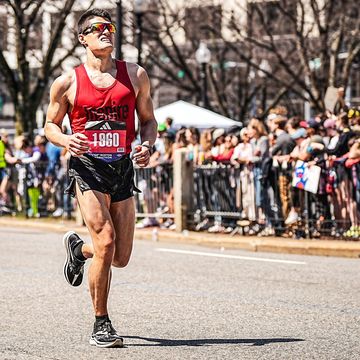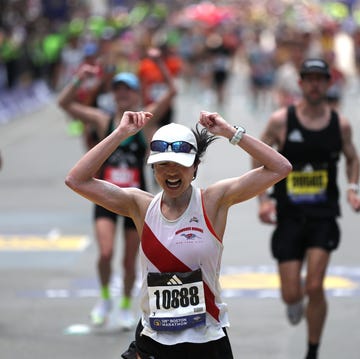Running strong past your 30s takes dedication. As you age, your body faces new challenges, and new roles and responsibilities enter your life that affect where, when, and how long you can run. We talked to nine runners about the day-to-day physical and logistical challenges of running in your 40s, 50s, 60s, 70s, and older to steal their tips for staying fast (and in some cases, becoming faster than ever!).
Then, experts weigh in on each runner's habits to talk about how you can apply their strategies to your running life. Plus, how to fuel your runs in each age bracket.
Build Recovery Habits
Khadevis Robinson, 44, Columbus, OH
Two-time Olympian, 800m (2004, 2012)
If you take care of your body, you can compete for a long time. I made my last Olympic team when I was 36 years old. But you have to adapt as you age. When you’re a young athlete, you’re still developing. You’re pushing to get stronger and faster. But once you’ve built the athleticism you need for your sport [and reached your ceiling], you don’t have to train the same, because you hit a rate of diminishing returns. Injuries come from pushing to get better and not being able to recover.
I still train six days a week, because it’s how I get my thinking in, but if I go hard two days in a row, I’m risking injury. I follow every high- intensity day with two low-intensity days, even if I feel great. On low-intensity days, I drop my effort to 70 percent. After a hard 10-mile tempo run, I’ll do 7 miles the next day, or run at 70 percent of my previous pace. When I do strength work, I use lighter weights or perform fewer reps, and I prioritize more rest between sets. I always stretch after workouts, and on off days, I’ll soak in hot water with Epsom salt, take vitamin D, and even go get a massage. To make sure I get enough protein, I take collagen, eat boiled eggs, and supplement with whey protein shakes.
The Experts Say: Reduce intensity and emphasize protein in your 40s to maintain muscle strength and cardiovascular endurance. By the time men hit age 40, strength and cardio start to drop by a percent or two per year, according to a study in Sports Medicine. Training smarter instead of harder—that means prioritizing recovery—helps you maintain performance, says Dr. Michael Fredericson, director of sports medicine at the Stanford University School of Medicine. He advises runners to do only two or three high-intensity runs a week. Research from the Netherlands suggests that eating 40 grams of protein after a training session can restore muscle faster than if you’d skimped on the protein, and research from Spain shows that adequate vitamin D is associated with improved performance and lower risk of injury. —As Told To Michael Easter
Reach for Your Peak
Natalie Mitchell, 48, Pacific Palisades, CA
Ran a 3:05 Marathon PR at age 46
I’ve been running almost my entire life, but I didn’t go all in with my training until my 40s. I began working with a coach at 42, which I hadn’t done since my college running career. I became strong and fast again, and when I was 46, I ran my marathon PR at the 2019 Mesa-Phoenix Marathon. In my late 40s, I feel my metabolism slowing down. Middle age is telling my body to preserve its fat stores, so to combat this, I’m more consistent and diligent about fueling to support my running. I have some protein 30 minutes after a hard workout, I eat two eggs every morning, and I make a protein shake midmorning or early afternoon. My protein go-tos include grass-fed beef, wild salmon, edamame, tofu, and raw almonds. I have to be willing to listen to my body and give it what it wants.
I’m perimenopausal, and at this age, my periods sometimes bring a real damper to my days. I feel more emotional than ever right before my period, and I experience intense cramping during my period. Hydration keeps headaches at bay. And if I have low energy because of extreme PMS, I give myself the freedom to take a nap or postpone a hard workout. And now that my kids have gotten older and I don’t need to change diapers, nurse babies, or be up a lot during the night, I make sure I’m in bed by 10 and up by 6. My best advice for female runners in their 40s: You need the positivity running can bring now more than ever. The natural endorphins help ease my discomfort from PMS.
I’ve heard many women count themselves out because they are inching toward 40. What if we thought about turning 40 as just the beginning? I don’t think of myself as an “older runner.” I haven’t reached my potential yet in this sport, and that drives me to keep training hard.
The Experts Say: Hormonal changes can diminish muscle and power in your 40s, so prioritize strength over endurance. “As estrogen and progesterone fluctuate and decline [during menopause], runners can experience muscle loss, loss of power, hot flashes, increased stress, and inflammation,” says female-performance physiologist Stacy Sims, Ph.D. Less estrogen makes it difficult for women to rebuild muscle, so consume more protein—0.7 grams per pound of bodyweight daily. Women also lose bone density with age, so supplementing magnesium, vitamin K2, calcium, and vitamin D3 can help you maintain a strong skeleton, per a 2020 study in Maturitas. —As Told To Emily Shiffer, With Additional Reporting By Selene Yeager
Find More to Love In Every Mile
Rich Roll, 54, Calabasas, CA
2017 finisher, Ötillö Swimrun World Championship
In my 40s, my relationship with running was very performance-oriented. In my 50s, I don’t feel like I have anything to prove, but it’s still a challenge transitioning from being wed to the metrics to just falling in love with running.
As I’ve aged, I’ve had to pay more attention to running technique—like making sure that I’m upright and that I’m not heel striking—and recovery, icing, and taking stretch breaks throughout the day rather than sitting for hours in a row. But in terms of restoration and performance, an excellent night of sleep makes a bigger difference than any other recovery modality I’m aware of. Consequently, I’m protective of my sleep schedule. I’m strength-training now way more than I used to. Being strong through the middle section of my body keeps my form in alignment when I’m running. I do simple core exercises like reverse planks and Swiss ball rollouts.
The most important metric for me now is, Do I feel good throughout the day? Do I feel fit? Am I enjoying running and being in nature and being one with my breath and heart rate? Running for me is an active form of mindfulness that is about engaging with my physical self and getting all kinds of emotional, mental, and spiritual benefits. It makes me a better person, a better parent, and more present and grateful in my life.
The Experts Say: Amid a loss of muscle mass and testosterone levels, focus on movement quality, correct imbalances, and start experimenting, says Peter Park, C.S.C.S., three-time winner of the World’s Toughest Triathlon. Planks, squats, deadlifts, push-ups, and pull-ups with good technique can help you keep a balanced running form. Don’t neglect calf raises—Achilles issues are common among men in their 50s.
Park adds that racers in their 50s should quit worrying about PRs and enjoy the ride. “Put away heart monitors, pace charts, and goals. If you feel good, go faster. If not, go slower. Focus on your breath and the experience, and let running become your meditation.” —As Told To M.E.
Mobilize to Add Power
Erin Carson, 54, Boulder, CO
2019 finisher, IRONMAN 70.3 World Championship
In my 50s, I don’t need volume. I need interval work and strength sessions to maintain speed, muscle strength, and mobility.
Now I do a long run every 10 days or so instead of every Sunday. And I perform mobility work most days and after every run, including miniband exercises and foam-rolling. I also use Eric Goodman’s Foundation Training to activate my posterior muscle chain, anchor my hips, and decompress my spine. This approach uses bodyweight exercises like windmills to promote healthy posture, which is important for women my age because we tend to bend forward around this time and tighten up. As a runner in your 50s, you want a big open chest, supportive upper back muscles, and mobility to pump your arms and drive your speed. I love heavy strength-training, like deadlifts, because you get a full-body hormonal response that lowers cortisol [a stress hormone that increases inflammation]. Straight-bar deadlifts can put strain on your lower back if you have tight hips, so I use a hex bar to deadlift in a more upright position. Twice a week I follow my run with four sets of six deadlifts.
My strategy now—to quote Survivor—is to outwit, outplay, outlast my age group by staying healthy and strong. I’ve found that I’ve been able to maintain my speed in my 50s if I put as much focus into recovery as I do the rest of my training. Since sleep is when everything repairs, I keep a consistent schedule—asleep by 8, up at 4:30—and I protect my sleep quality by limiting alcohol to one glass of red wine at night, and allowing two hours before bed to digest dinner.
The Experts Say: Build mobility to stay elastic and prevent injury, says Jordan Metzl, M.D., sports medicine doctor at New York City’s Hospital for Special Surgery. “Muscles and connective tissues lose elasticity, which shortens your stride. People who only run tend to develop injuries as they get tight and lose strength. Building strength and mobility through your entire kinetic chain—all of the muscles, ligaments, tendons, and bones running the length of your body—is extremely important,” he says. That’s especially true for women, because they start with less muscle than men. Managing stress is important, too, because lower levels of estrogen can result in increased anxiety. While strength training helps with that, supplement your workouts with lots of sleep: Most experts agree six hours is the absolute minimum. —As Told To Selene Yeager
Feed Your Muscles to Stoke Your Speed
Anselm LeBourne, 61, West Orange, NJ
60-64 800m indoor world record holder: 2:11.80.
Once the pandemic ends, I’m planning to go back to chasing records on the track in the 1500 meters and the mile, so I feel I need to get stronger. I’m not a fan of lifting weights, so I’ve started incorporating a hill workout once a week into my running routine. I think it’s the most difficult workout I do. The hill is about 150 meters—a gradual uphill climb for the first 130 meters, then steep for the last 20. I run it 10 times, jogging back down and going right into the next one. I can feel how the hills have made me stronger when I’m doing my track workouts.
In my 60s, I need to give myself more time for workouts. In my 50s, I could do 10 quarters with one minute rest. Now I need two minutes of rest if I want to complete the whole workout with quality. I also give myself at least a mile and a half for warmup and cooldown, sometimes two miles. I think diet is important as well, as you get older. I’ve been vegan for more than a decade because I felt I was able to sleep better and train harder with a clean diet. Less sugar helped tremendously. In the mornings, I make a special smoothie with different greens, plant protein, garlic, spirulina, pumpkin seeds, and two bananas. I love that smoothie. I mostly snack for lunch, and dinner could be rice and beans or a big salad with lots of different vegetables.
The Experts Say: Maintain stride length by working your glutes and hamstrings. Marathoners in their 60s had stride lengths 16 percent shorter than those of marathoners in their 40s, per a 2006 study from the British Journal of Sports Medicine. Hills can help older runners build leg strength and speed to keep strides long, says Greg McMillan, running coach and exercise physiologist. But approach hills carefully. McMillan suggests you have a consistent, strong running base, with strides at least twice per week, before you try hills. Start with shorter hills at a slow pace and build up gradually.
McMillan adds that men and women in this age group might experience noticeable weight gain. You lose muscle tissue as you age, which slows your metabolism and contributes to a higher percentage of body fat. A high-protein diet helps preserve lean muscle mass, and dietitian Leslie Bonci says runners in their 60s need at least 20 grams per meal, but should aim for 0.6 to 0.8 grams of protein for each pound of bodyweight daily. (For a 140-pound person, that’s 84 to 112 grams.) Bonci says calcium, vitamin D, and vitamin K are critical for bone health in this age group as well, plus dietary fiber—women over 50 should aim for 20 grams per day, and men should aim for 30. —As Told To Sarah Lorge Butler
Seek Running Adventures
Nancy Ditz Mosbacher, 66, Woodside, CA
1988 Olympic marathoner, ran a 3:08.46 800m at 65
At the Olympic Marathon trials in 1992, I was with the lead pack after the halfway point, but my heart wasn’t in it. I stepped off the course and quit running for the next 22 years. I was incredibly happy and busy with my family, but when my daughter and I decided to run the 2016 Boston Marathon together, I started training again when I was 60. That’s when I realized I missed running.
During my competitive career, I had been relatively healthy. The second time around, it was a different story. I’ve had sciatica, tight IT bands, and I tore the meniscus in both knees. A lot of my injuries have come from weak hips, so now I spend at least 10 minutes every day rolling my IT bands and working on mobility. I have an arsenal of rollers and a Hypervolt, and I see a physical therapist every two weeks. My other areas of focus are my hip flexors, pelvis, and thoracic spine [upper to mid-back]—I probably spend too much time hunched in front of my computer. During my competitive career, I ran solo. But since my comeback, running has become a social activity for me. I’ve trained with two different groups and developed deep friendships with the other runners. When necessary, I modify my workout so the faster people don’t have to wait for me. If they’re doing 1200-meter repeats, I’ll do 1000s. It gives me enough rest to get back to the starting line when they’re ready to go.
But I do most of my training on trails. There’s less pounding and more running adventures. My daughter and I ran the North Rim of the Grand Canyon together and camped out along the way. Trails also allow me to stop thinking about pacing and time as often as I might on the track or roads. It’s joyful. I’ve adjusted my attitude in that respect. I want to win my age group and stay competitive (even against the men), but now, I seek out the fun first.
The Experts Say: In your 60s, diversify where, when, and why you run. “Success in the 60s means reframing goals,” says Cathy Utzschneider, Ed.D., professor of high performance at Boston College. Adopt a “less is better” approach to training, and use your imagination to keep things fresh. You can use your running fitness to succeed in another sport: cycling, swimming, or even something like paddle tennis. Tony Coffey, coach of San Francisco’s Impala Racing Team, encourages cross country for his runners in their 60s because every course is different. And when you race in your 60s, Utzschneider recommends using an age-grading calculator, like the one on Mastersathletics, to score your performance on a curve. It’ll keep you competitive and be fair to your age. —As Told To S.L.B.
Embrace Leadership
Nancy Rollins, 74, Evanston, IL
Ran 3:58:13 at the Chicago Marathon at 72
There’s a gradual difference in speed between 65 and 70. You start noticing certain paces that used to be easy aren’t easy anymore. I started racing at age 32, and I’ve now done 95 marathons. I hit my PR, 3:02, when I was 43.
In my early 70s, I was slowing down, but still enjoying every bit of my running. But Easter 2020, I had a devastating fall. I was running with a neighbor, and my foot caught the edge of the curb, and I was launched in the air. I landed on my right shoulder and hit my head to give myself a black eye. Even worse, I tore my rotator cuff, and my biceps ripped off the bone. I had surgery, and although I was out walking with my husband three days afterward, I couldn’t run for three months. It was a very long recovery. My physical therapy helped me regain the full range of motion in my arm and shoulder, but I worked my whole body in PT, too. I did a lot of floor work: clamshells, side planks, hip raises, weights, bands. I always used to hate that stuff. But now I feel like I’m really in balance. I still do those exercises every day, and ironically, I feel better now than before I fell.
The accident has transformed my perspective on performance. In my early 40s, I would get down on myself if I had a bad race. Not anymore. Now, I have an immense gratefulness to just be out there. I think that’s why I’m an enduring competitor.
I’ve taken on a different role in my community at my age, too. I’m a coach at the Evanston Running Club, and I love to support and mentor people. If it’s a workout day, I’ll do the workout in the morning with runners my speed, then lead the workout and hold the stopwatch for another group at night.
The Experts Say: Prioritize balance and share your experiences with younger runners. “A comprehensive strength-training program should include balance work [in your 70s],” says McMillan. Do functional training, such as single-leg exercises, hamstring curls on a stability ball, and yoga. If you don’t have a strength routine at this age, just practice standing on one foot, then the other, for 10 seconds at a time.
Runners in their 70s should take advantage of their experience, says Utzschneider. “The brain is the biggest asset of the 70-something runner,” she adds. “Our brains help us be selective about what’s most important. Maybe it’s helping someone else get faster, whether you’re a coach or a training partner.” —As Told To S.L.B.
Outsmart Injury
Lynn Rathjen, 76, Grand Island, NE
75-79 road mile U.S. record holder: 5:59.18
Before I retired, I was a physical therapist, and I saw many long-distance runners increase their mileage too quickly and sit out for a long time with injury. So I kept my mileage low as I got older—about 20 miles per week—and I ran a couple of races each year to focus my training and keep me motivated.
In 2019, when I was 74, I went to the USATF masters outdoor nationals and finished second in the 1500. The scene at the starting line was kind of funny. The guys were all talking: “Yeah, I’ve had plantar fasciitis, I’ve had a calf strain, I’ve had IT-band pain. I’m slowing down a lot.” I enjoyed the camaraderie, but I didn’t have a lot to add, thankfully. I’ve been able to keep relatively healthy by being conservative with my mileage. In the winter, I go to the YMCA for aqua-jogging five days a week, sometimes followed by the treadmill. I wear a flotation belt, and the key with aqua-jogging is to keep your legs turning over. An easy run is about 165 to 170 “steps” per minute. At tempo pace, I get up to 190 steps.
When the weather improves, it takes a few runs on land to get back to my normal running paces. I do 20-minute tempo runs, and I go to the track for intervals with lots of rest. I figure at my age, once you stop intervals, it’s harder to get back into them again.
The Experts Say: Use speed workouts to stay fit and competitive, says Coffey. Running at varied paces will strengthen your running economy—the energy you need to run at a given pace, adds McMillan. That can help offset the gradual decrease in max heart rate—about a beat every year—that begins sometime after age 30.
But also integrate low-impact cross training that elevates your heart rate on easy days, says Coffey, such as cycling, swimming, or even walking, to lower your injury risk. —As Told To S.L.B.
FUELING YOUR RUNS THROUGH THE DECADES
Your body’s needs evolve as you age. These nutrition strategies will more efficiently fuel your runs, and maintain muscle mass to preserve strength and metabolism.
In Your 40s...
Stop running on an empty stomach. High-carb, low-fiber foods like bananas, toast, and yogurt before a run will boost your glucose uptake and enhance performance. Make hydration a habit. Thirst response declines with age. Drink half your body weight in fluid ounces per day, plus an additional 12 to 24 ounces per hour of exercise.
In Your 50s...
Bookend runs with protein. 8 to 10 grams before a run and 30 to 40 after a run is ideal. An egg, a serving of tofu, or a cup of Greek yogurt will do it prerun, while a two-egg scramble with black beans and turkey after your run will promote recovery.
In Your 60s...
Carbs, carbs, carbs! Within 30 minutes after a run, fast-absorbing carbs help restore your glycogen, promoting better subsequent workouts. Sweet potatoes and brown rice work, but why not have some pancakes or waffles? (Three 4-inch pancakes provide about 60 grams of carbs.)
In Your 70s and Beyond...
Fuel with a meal. Eating something balanced 90 to 120 minutes before you run will boost immune function and decrease inflammation. Try a turkey sandwich with avocado on whole grain bread. Have a bedtime snack! Studies show that eating foods containing slow-digesting casein protein increases metabolic rate. Dairy is rich in casein.
Lauren Antonucci, RDN, CSSD, is the author of High-Performance Nutrition for Masters Athletes.
WHY RUNNING IS STILL AWESOME AFTER 100
I decided to try running when I was 100 years old. I think having challenges as you get older is important, because it keeps your interest in something. For me, that’s running. My kids encouraged me to participate in the Senior Games, and in 2017, I set a new National Senior Games 100+ record for the 50-meter race. I finished in 18.31 seconds.
I’m 105 now, but I still train every day. For me, that’s walking about a mile a day around my neighborhood. It’s a safer and more sustainable way for me to stay active, and I’ve been lucky my feet, knees, and hips have remained injury-free. I’ve found that when I start running, my body pumps up and gives me whatever it takes to make me fly. When I run a race, I’m out of breath, and when I get to the end, I need to be caught by someone so I don’t fall down. I love the feeling. My children tell me I’m supposed to inspire people to keep healthy and keep doing active things. So my advice to any runner is to eat right, keep moving, and keep a competitive edge. Keep wanting to win.
By Julia Hawkins, As Told To Emily Shiffer
